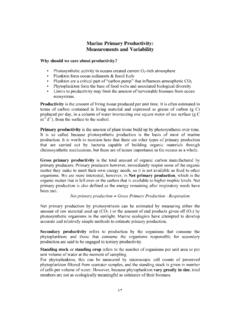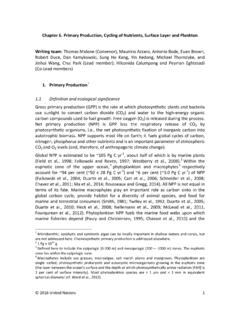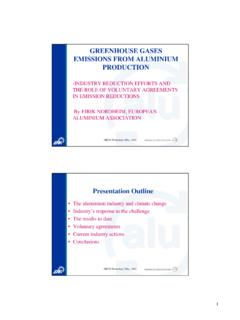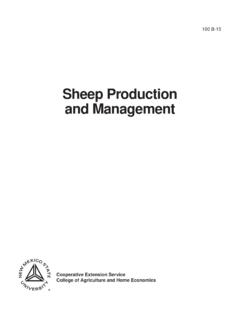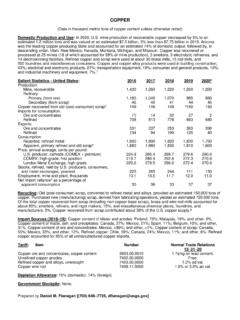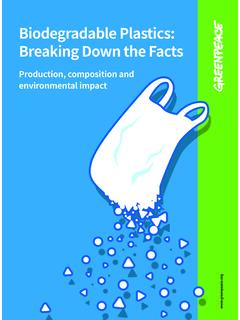Transcription of 12.3 Primary Copper Smelting
1 Primary Copper General1 Copper ore is produced in 13 states. In 1989, Arizona produced 60 percent of the totalU. S. ore. Fourteen domestic mines accounted for more than 95 percent of the megagrams (Mg)( millon tons) of ore produced in is produced in the U. S. primarily by pyrometallurgical Smelting techniques use heat to separate Copper from Copper sulfide ore concentrates. Processsteps include mining, concentration, roasting, Smelting , converting, and finally fire and Process Description2-4 Mining produces ores with less than 1 percent Copper . Concentration is accomplished at themine sites by crushing, grinding, and flotation purification, resulting in ore with 15 to 35 percentcopper. A continuous process called floatation, which uses water, various flotation chemicals, andcompressed air, separates the ore into fractions. Depending upon the chemicals used, some mineralsfloat to the surface and are removed in a foam of air bubbles, while others sink and are oils, cresylic acid, and long-chain alcohols are used for the flotation of Copper ores.
2 The flotationconcentrates are then dewatered by clarification and filtration, resulting in 10 to 15 percent water,25 percent sulfur, 25 percent iron, and varying quantities of arsenic, antimony, bismuth, cadmium,lead, selenium, magnesium, aluminum, cobalt, tin, nickel, tellurium, silver, gold, and typical pyrometallurgical Copper Smelting process, as illustrated in Figure , includes 4steps: roasting, Smelting , concentrating, and fire refining. Ore concentration is roasted to reduceimpurities, including sulfur, antimony, arsenic, and lead. The roasted product, calcine, serves as adried and heated charge for the Smelting furnace. Smelting of roasted (calcine feed) or unroasted(green feed) ore concentrate produces matte, a molten mixture of Copper sulfide (Cu2S), iron sulfide(FeS), and some heavy metals. Converting the matte yields a high-grade "blister" Copper , with percent Copper . Typically, blister Copper is then fire-refined in an anode furnace, cast into"anodes", and sent to an electrolytic refinery for further impurity is performed in Copper smelters prior to charging reverberatory furnaces.
3 In roasting,charge material of Copper concentrate mixed with a siliceous flux (often a low-grade Copper ore) isheated in air to about 650 C (1200 F), eliminating 20 to 50 percent of the sulfur as sulfur dioxide(SO2). Portions of impurities such as antimony, arsenic, and lead are driven off, and some iron isconverted to iron oxide. Roasters are either multiple hearth or fluidized bed; multiple hearth roastersaccept moist concentrate, whereas fluidized bed roasters are fed finely ground material. Both roastertypes have self-generating energy by the exothermic oxidation of hydrogen sulfide, shown in thereaction below.(1)H2SO2 SO2H2 OThermal energyIn the Smelting process, either hot calcine from the roaster or raw unroasted concentrate ismelted with siliceous flux in a Smelting furnace to produce Copper matte. The required heat comesfrom partial oxidation of the sulfide charge and from burning external fuel. Most of the iron and10/86(Reformatted 1/95)Metallurgical Typical Primary Copper smelter process.
4 (Source Classification Codes in parentheses.) FACTORS(Reformatted 1/95)10/86some of the impurities in the charge oxidize with the fluxes to form a slag on top of the molten bath,which is periodically removed and discarded. Copper matte remains in the furnace until ranges from 35 to 65 percent Copper , with 45 percent the most common. The Copper contentpercentage is referred to as the matte grade. The 4 Smelting furnace technologies used in the U. S. arereverberatory, electric, Noranda, and reverberatory furnace Smelting operation is a continuous process, with frequent chargingand periodic tapping of matte, as well as skimming slag. Heat is supplied by natural gas, withconversion to oil during gas restrictions. Furnace temperature may exceed 1500 C (2730 F), with theheat being transmitted by radiation from the burner flame, furnace walls, and roof into the charge ofroasted and unroasted materials mixed with flux. Stable Copper sulfide (Cu2S) and stable FeS formthe matte with excess sulfur leaving as sulfur arc furnace smelters generate heat with carbon electrodes that are lowered through thefurnace roof and submerged in the slag layer of the molten bath.
5 The feed consists of driedconcentrates or calcine. The chemical and physical changes occurring in the molten bath are similar tothose occurring in the molten bath of a reverberatory furnace. The matte and slag tapping practicesare also Noranda process, as originally designed, allowed the continuous production of blistercopper in a single vessel by effectively combining roasting, Smelting , and converting into 1 problems, however, led to the operation of these reactors for the production of coppermatte. The Noranda process uses heat generated by the exothermic oxidation of hydrogen heat is supplied by oil burners or by coal mixed with the ore concentrates. Figure the Noranda process furnace Smelting combines the operations of roasting and Smelting to produce a high-grade Copper matte from concentrates and flux. In flash Smelting , dried ore concentrates and finelyground fluxes are injected together with oxygen and preheated air (or a mixture of both), into afurnace maintained at approximately 1000 C (1830 F).
6 As with the Noranda process reactor, and incontrast to reverberatory and electric furnaces, flash furnaces use the heat generated from partialoxidation of their sulfide charge to provide much or all of the required produced by flash furnace operations contains significantly higher amounts of Copper thanreverberatory or electric furnaces. Flash furnace slag is treated in a slag cleaning furnace with coke oriron sulfide. Because Copper has a higher affinity for sulfur than oxygen, the Copper in the slag (ascopper oxide) is converted to Copper sulfide. The Copper sulfide is removed and the remaining slag produces blister Copper by eliminating the remaining iron and sulfur present in thematte. All but one U. S. smelter uses Pierce-Smith converters, which are refractory-lined cylindricalsteel shells mounted on trunnions at either end, and rotated about the major axis for charging andpouring. An opening in the center of the converter functions as a mouth through which molten matte,siliceous flux, and scrap Copper are charged and gaseous products are vented.
7 Air, or oxygen-rich air,is blown through the molten matte. Iron sulfide is oxidized to form iron oxide (FeO) and and slag skimming continue until an adequate amount of relatively pure Cu2S, called "whitemetal", accumulates in the bottom of the converter. A final air blast ("final blow") oxidizes the coppersulfide to SO2, and blister Copper forms, containing 98 to 99 percent coppers. The blister Copper isremoved from the converter for subsequent refining. The SO2produced throughout the operation isvented to pollution control (Reformatted 1/95)Metallurgical domestic smelter uses Hoboken converters. The Hoboken converter, unlike the Pierce-Figure Schematic of the Noranda process converter, is fitted with an inverted u-shaped side flue at one end to siphon gases from theinterior of the converter directly to an offgas collection system. The siphon results in a slight vacuumat the converter in blister Copper may include gold, silver, antimony, arsenic, bismuth, iron, lead,nickel, selenium, sulfur, tellurium, and zinc.
8 Fire refining and electrolytic refining are used to purifyblister Copper even further. In fire refining, blister Copper is usually mixed with flux and charged intothe furnace, which is maintained at 1100 C (2010 F). Air is blown through the molten mixture tooxidize the Copper and any remaining impurities. The impurities are removed as slag. The remainingcopper oxide is then subjected to a reducing atmosphere to form purer Copper . The fire-refined copperis then cast into anodes for even further purification by electrolytic refining separates Copper from impurities by electrolysis in a solution containingcopper sulfate (Cu2SO4) and sulfuric acid (H2SO4). The Copper anode is dissolved and deposited atthe cathode. As the Copper anode dissolves, metallic impurities precipitate and form a Copper , to percent pure, is then cast into bars, ingots, or Emissions And ControlsEmissions from Primary Copper smelters are principally particulate matter and sulfur oxides(SOx).
9 Emissions are generated from the roasters, Smelting furnaces, and converters. Fugitiveemissions are generated during material handling , Smelting furnaces, and converters are sources of both particulate matterand SOx. Copper and iron oxides are the Primary constituents of the particulate matter, but otheroxides, such as arsenic, antimony, cadmium, lead, mercury, and zinc, may also be present, along withmetallic sulfates and sulfuric acid mist. Fuel combustion products also contribute to the particulateemissions from multiple hearth roasters and reverberatory effluent from roasters usually are sent to an electrostatic precipitator (ESP) or spraychamber/ESP system or are combined with smelter furnace gas effluent before particulate , the hot ESPs remove only 20 to 80 percent of the total particulate (condensed and vapor)present in the gas. Cold ESPs may remove more than 95 percent of the total particulate present in FACTORS(Reformatted 1/95)10/86gas.
10 Particulate collection systems for Smelting furnaces are similar to those for furnace off-gases are usually routed through waste heat boilers and low-velocity balloonflues to recover large particles and heat, then are routed through an ESP or spray chamber/ESP the standard Pierce-Smith converter, flue gases are captured during the blowing phase bythe Primary hood over the converter mouth. To prevent the hood from binding to the converter withsplashing molten metal, a gap exists between the hood and the vessel. During charging and pouringoperations, significant fugitives may be emitted when the hood is removed to allow crane off-gases are treated in ESPs to remove particulate matter, and in sulfuric acid plants toremove smelter operations process material containing very little sulfur, resulting ininsignificant SO2emissions. Particulate may be emitted from fire refining operations. Electrolyticrefining does not produce emissions unless the associated sulfuric acid tanks are open to theatmosphere.










